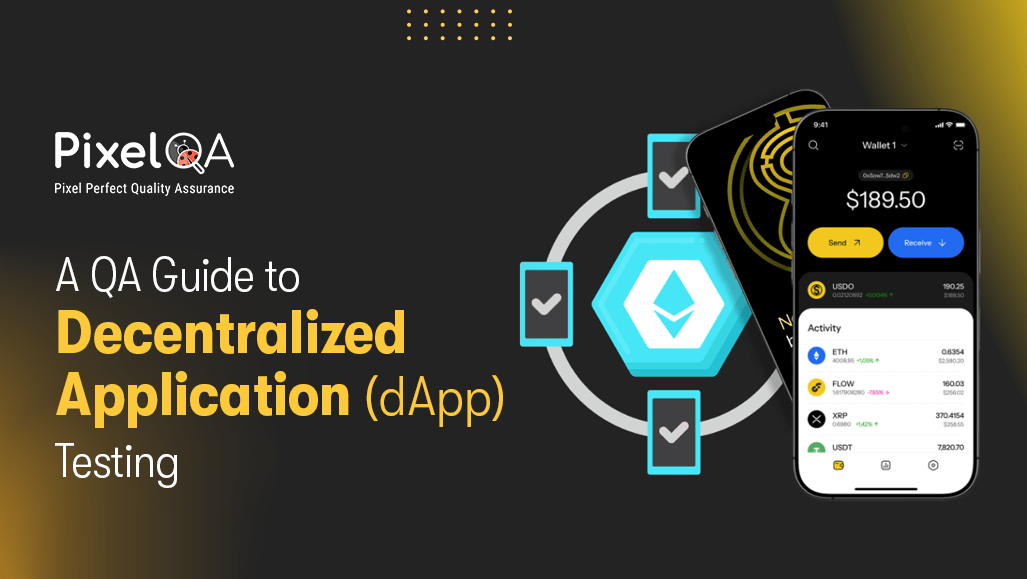
Table of Contents
- Introduction
- Understanding the dApp Testing Landscape
- What Makes dApp Testing Different?
- Key Components to Validate
- The QA Process for dApp Testing
- 1. Smart Contract Testing
- 2. Integration and API Testing
- 3. Performance and Load Testing
- 4. Security Testing
- 5. User Interface and Usability Testing
- Benefits of a Robust dApp QA Strategy
- Building a Future-Ready QA Approach
- Conclusion
Introduction
Blockchain technology is transforming how digital systems function, from central authority models to decentralized, self-managed architectures. Businesses across industries are adopting dApps to improve transparency, security, and user-controlled interactions.
But innovation brings complexity. Unlike traditional apps, dApps run on distributed networks. Data, logic, and execution are spread across multiple nodes. While this eliminates single points of failure, it introduces unique quality assurance challenges.
A small bug in a smart contract can freeze assets worth millions. Network latency varies. Security issues can not be easily patched after deployment. For decision-makers, QA is not optional; it is mission-critical. That is the reason why partnering with a trusted software QA services company is essential to ensure your systems stay secure, reliable, and deployment-ready.
This blog simplifies the essentials of dApp testing from a QA perspective, helping leaders and professionals understand what matters and how to ensure their decentralized applications perform reliably.
Understanding the dApp Testing Landscape
What Makes dApp Testing Different?
A dApp is more than a web app with a blockchain backend. It includes both on-chain and off-chain components such as smart contracts, interfaces, APIs, wallets, and distributed storage.
Traditional testing tools cannot fully validate these systems due to blockchain immutability, consensus rules, and cryptographic transactions. Smart contracts are immutable; you cannot fix them after deployment. Testing must therefore be rigorous, thorough, and security-driven.
Key Components to Validate
A robust dApp QA strategy should validate the following:
- Smart Contracts: Logic, security, gas optimization
- Blockchain Layer: Consensus, node sync, transaction flow
- Frontend/UI: UX across wallets, devices, browsers
- APIs and Middleware: On-chain and off-chain communication
- Performance: Load handling across distributed nodes
- Security: Penetration testing, vulnerability detection
The QA Process for dApp Testing
1. Smart Contract Testing
Smart contracts are the foundation of any dApp. QA teams use tools like Hardhat, Truffle, and Ganache to simulate blockchain behavior and run unit tests.
Common checks include:
- Functionality verification
- Security vulnerabilities (reentrancy, overflow, etc.)
- Gas usage optimization
- Compatibility with upgrade patterns
2. Integration and API Testing
dApps integrate with wallets, oracles, and various APIs. QA teams validate these connections while simulating latency, transaction confirmation time, and network failures. Tools like Postman and custom automation frameworks are commonly used.
3. Performance and Load Testing
Scalability is crucial. QA teams simulate high-volume traffic and multi-node interactions to detect performance bottlenecks in both smart contracts and network layers.
4. Security Testing
Security testing is vital due to irreversible blockchain transactions. QA teams perform:
- Static code analysis
- Automated audits (Slither, MythX)
- Manual penetration testing
- Testing for replay attacks, timestamp misuse, DoS exploits
5. User Interface and Usability Testing
Despite decentralized complexity, users expect simple interactions. QA teams ensure smooth wallet connections, accurate transaction prompts, cross-browser compatibility, and accessibility compliance.
Benefits of a Robust dApp QA Strategy
1. Enhanced Security and Compliance
Prevent vulnerabilities, financial loss, and compliance risks.
2. Optimized Performance and Cost Efficiency
Efficient contracts reduce gas fees and improve speed.
3. Faster Time-to-Market
Automated test pipelines enable faster, safer deployments.
4. Improved User Experience
A smooth interface builds user trust and credibility in the decentralized ecosystem.
Building a Future-Ready QA Approach
Businesses that include QA early in the development lifecycle will lead the next wave of blockchain innovation. QA becomes a strategic enabler that ensures every smart contract and transaction works flawlessly.
Conclusion
In decentralized systems, trust is earned through testing. One small oversight can break an entire ecosystem. With the right QA framework, your dApp delivers transparency, efficiency, and reliability. Now is the time to invest in strong dApp QA practices with partners who understand blockchain deeply, from smart contract testing to user-focused validation.

